Banks have not prepared to retain control of customers and merchant payment interfaces in the face of blockchain or distributed ledger, according to managing consultant firm Bain & Company white paper.
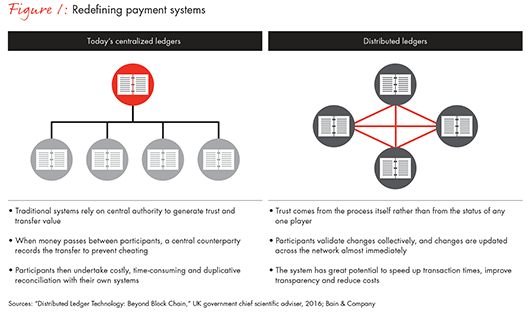
Such technology removes intermediaries, simplifies counterparty connections and records data in a tamper-proof manner. It also promises faster speed, more transparency and efficiency for payments.Bitcoin, despite some flaws, demonstrates these possibilities and has attracted a surge of investment. Ripple Labs, a blockchain startup, holds a seat on the Federal Reserve Faster Payments Task Force.Bain & Company, a financial consultantcy, interviewed more than 50 venture capitalists, bankers, payment association executives, bankers and startup CEOs. The interviewees indicated that banks are positioned to address the changes caused by distributed ledgers, but the situation is complicated.The paper attempted to clarify the different ways banks are responding to distributed ledgers and the opportunities they offer.Distributed ledgers will determine successes and failures within the banking industry, the paper noted.
Distributed Ledgers Tap Existing Systems
The paper gave an overview of distributed ledger technology. It noted they combine existing technologies in novel ways. These include:
- The blockchain is a secure record of transactions collected into blocks grouped in chronological order and distributed over different servers to provide reliable provenance.
- Digital signatures are digital keys that authorize and check transactions and identify the initiator.
- A consensus mechanism consists of techniques that ensure participants processing transactions agree on which ones are valid.
- Digital currency is, in some implementations, a cryptographic token representing value. Central banks could create digital currencies.
Distributed Ledgers Vary
Distributed ledgers’ features vary. Some, like bitcoin, permit any participant to validate transactions. Others, like Ripple, limit permission to a group of trusted parties.Distributed ledgers will follow two paths. One will be the development of systems focusing on global payments. The other will involve a broader disruption of domestic payments by central-bank-supported digital fiat currencies.
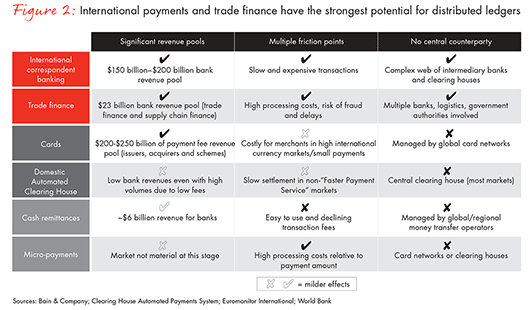
In the first path, financial institutions will seek opportunities for improvement, offering rewards for innovators in which no central counterparty like central banks will dominate.International payment services offer the most promising starting points, especially correspondent trade finance and banking. Global payments can take days to settle. They also lack transparency and often fail on account of messaging errors.Domestic payment services, by contrast, like automated clearing houses and credit cards, work well and therefore don’t have a strong need for change.
Disruption Is Coming
Broad disruption will eventually emerge. Signs are already emerging for the second path noted above. Central banks have already begun to consider issuing national digital currencies. If central banks make digital money available publicly rather than for internal use, it will have a big impact on domestic banking.Under this scenario, retail banks could lose their privileged status with customers and face competition for funding and lending products. Automated clearing house and credit card industries could become obsolete.Global financial institutions, without a central intermediary, have created a workaround for customers. Banks have correspondent or bilateral relationships with each other, settling transactions directly. Should two banks not have a direct relationship, they tap other banks as intermediaries.
Digital Ledgers’ Distinct Benefits
Digital ledgers provide distinct benefits by reducing the middlemen and allowing direct transactions among counterparties. They speed transactions and ensure the participants have a complete view of customer accounts. These are the building blocks of automated payment notification and tracking.
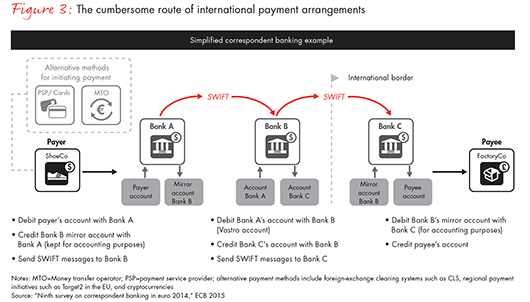
These benefits would meet customer needs for a more holistic view of their financial positions.Digital ledgers could also cut costs and errors. Banks have to pre-fund settlement accounts. Distributed ledger transactions, by contrast, settle nearly immediately and limit liquidity costs.Foreign exchange costs could also be reduced due to improved transparency on foreign exchange margins.
Existing System Is Entrenched
The existing market structure gives existing players incentive to preserve the status quo. An estimated $300 trillion in transactions move through global correspondent banking networks yearly, delivering $150 billion to $200 billion in bank revenues.Participants will not join a network before it has sufficient reach, which only comes from widespread participation. 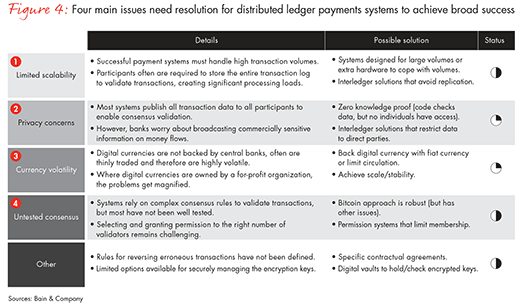
Ripple is the best known company addressing this challenge, having created an international payment system around a protocol and currency. Ripple has raised $40 million in capital and works with 30 banks on pilot tests of its software.
Why Banks Are Wary
Financial institutions are hesitant about distributed ledger based on concerns about the technology’s scalability, privacy issues for sensitive information, and the governance and volatility of the bridge currency.There is nonetheless evidence companies will overcome these hurdles. Investment in bitcoin and startups indicate a rising level of interest.In the consumer market, companies like TransferWise use existing technologies to provide improved services. Corporate customers are taking notice.
Existing Systems’ Shortcomings
About 60% of corporate treasurers are not satisfied with banks’ current payment services, according to an industry survey.Banks are appointing mid-level technology executives to industry consortia and are participating in conferences and running limited distributed ledger simulations. But this might not be a sufficient response. Without a clear strategic plan, banks risk postponing important decisions until it becomes too late to respond effectively.Digital ledgers provide a practical way for super-regional banks to compete with global transaction banks by replicating their networks at reduced costs and stronger customer offerings.
What Banks Should Do
Banks will need to select the right partners and the right number of partners. Without these, the network will not compel customers. Super regionals should build relationships with a select group of natural allies with complementary geographical coverage.They also have to establish more complex initiatives and alliances. They can focus on specific products, such as interbank payment services, that they can develop rapidly as a way to establish confidence, momentum and experience.Global banks have opportunity, but they need to act. By doing nothing, they could lose to new competitors. By overcoming institutional inertia, they can leverage their scale, their IT expertise and their relationships to improve their current networks.
Trade Finance Opportunities
Trade finance, a smaller sector than global correspondent banking, has similar characteristics. It supports broader transaction banking relationships and has its share of frictions. Nearly half of banks’ cost for a letter of credit is due to manual document management, creating errors, expense and delays. Hence, digital ledgers offer potential improvements.Trade finance is especially suited to distributed ledger solutions since it involves commitments from unrelated parties subject to different legal regimes.Digital identification offers immediate improvements to trade finance, including better fraud improvement.Digital ledger will also speed settlement and cut costs by mechanizing messages and receipt of payment. Smart contracts will speed transaction flows.Trade finance will change more slowly than global correspondent banking. Previous efforts to develop global standards for trade finance have failed, indicating no single bank can bring enough influence to change existing behaviors.
Opportunities Require Action
Pressures are growing on both international correspondent banking and trade finance. Banks will have to adopt new strategies.For super regional banks, digital ledger provides a way to establish a beachhead in a market that global banks currently dominate. The super regionals have to focus on the trade corridors in which they already have a footprint. They can collaborate with logistics and shipping companies, and customs and port authorities, to solve technical issues and build credibility and experience.
Domestic Payment Systems Face Disruption
While domestic payment systems function efficiently in developed nations, there is potential for long-term disruption.Central banks are exploring ways to issue national digital currency based on digital ledgers. The central banks are attracted to more direct control over the execution of monetary policy, improved tracking of financial payments, and automated tax collection.If businesses and consumers could exchange electronic payments without needing an ACH system, there would be no need for current checking accounts. Banks could find themselves in competition for deposits and lending.
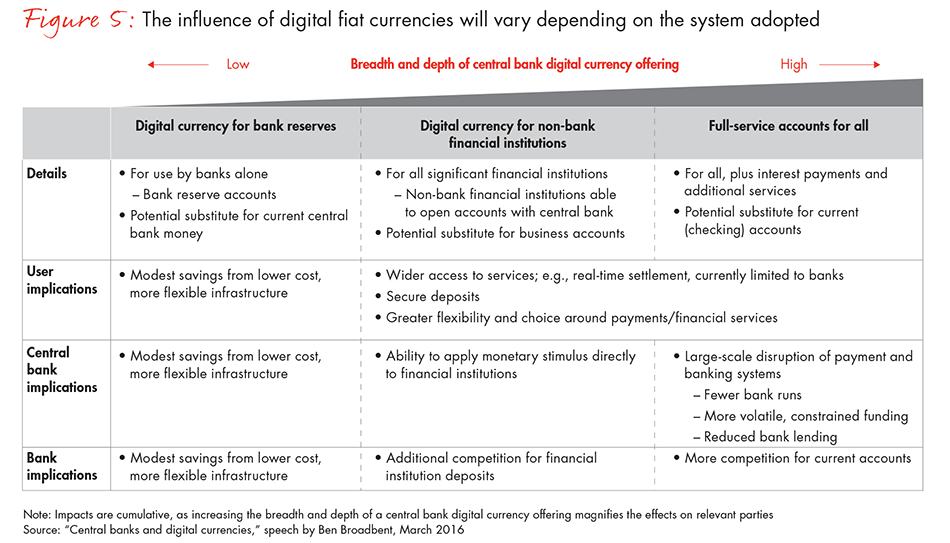
Central banks will proceed cautiously. Commercial banks could create their own private digital currencies.
Change Is Coming
Whatever the motivating factors, digital currencies will amplify trends that are already reshaping the banking industry.In Europe, new laws are removing banks’ hold on customer data. Payment wallets from Google, Apple and other technology firms are undermining banks’ customer relationships. To address this, banks can find ways to prepare customers for short term dislocation and the eventual arrival of digital currency.Banks can accelerate investment in digital wallets and payment apps. They can reframe regulatory compliance as a source of competitive advantage. They can invest in services and startups related to securing digital identities.
Questions To Consider
Banks should ask the following questions:• How prepared is the organization for digital ledgers and related technologies?
• Which systems should the organization be concerned about and invest in? Which customers and peers should the organization work with, and on what terms, to develop digital ledgers?
• Is the strategy to be an innovator or a fast follower? How well does the organization know the technology and its commercial implications?
• What is the organization’s position on wallets? Retaining control of payment interfaces and customer identities? How robust is the plan to win the battle for customer wallets and digital identities?
Featured image from Shutterstock. Figures from Bain and Company.
I could not agree more with the disruption coming to the financial sector! Thank you for sharing this.
Downvoting a post can decrease pending rewards and make it less visible. Common reasons:
Submit
a taste to be informed
Downvoting a post can decrease pending rewards and make it less visible. Common reasons:
Submit